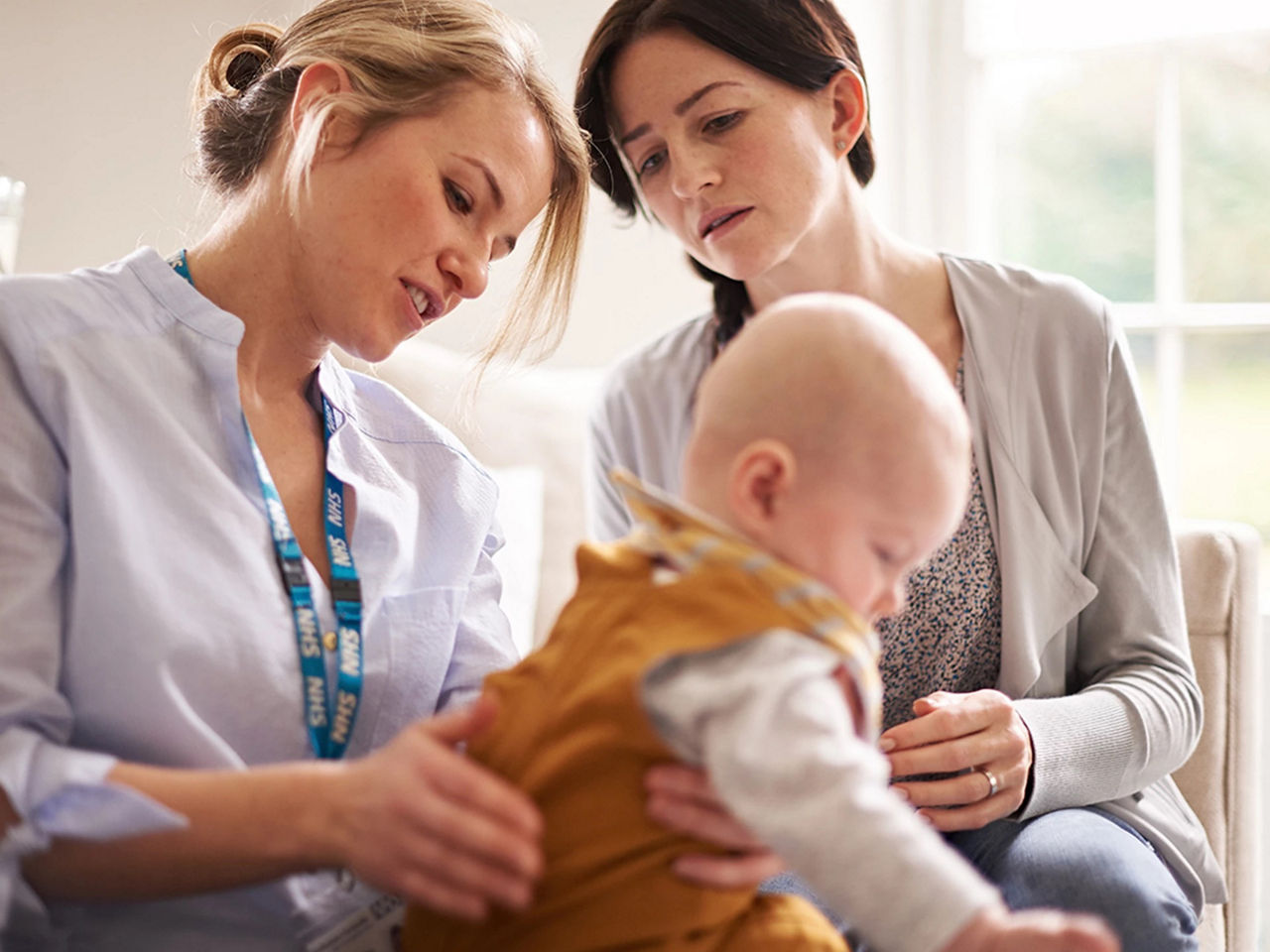Baby poo colour, smell, textures, and frequency:
From colour to consistency, here’s everything you can expect from your baby’s bowel movements

When you become a parent, you might be surprised at how much time you spend thinking and talking about poo – and for good reason. In the first few weeks, you could be changing 10-12 nappies per day, so you’ll soon get past any squeamishness you feel about poo1.
Believe it or not, paying attention to what’s going on with your baby’s bowel habits – including colour, texture and, of course, smell – can tell you a lot about your baby’s health and development.
Baby poo chart: what’s normal?
All babies (along with their nappies) are different. But it’s good to get a sense of what’s ‘normal’ for them and their age so you can quickly spot anything that might need checking out.
Use our baby poop chart by age guide for infants to see what you can expect depending on how they’re fed.
| Colour & consistency | Frequency | Smell | |
| Newborns1 | In the first 48 hours, your baby will have sticky, dark green or black poos called meconium | Twice or more in 24 hours | Mostly odourless | |
| Breastfed babies1,2 | Soft, yellow poos Might include small particles that look like seeds | First few weeks: baby pooing after every feed After 6 weeks: baby pooing once per day or less | A fairly weak, sweet smell | |
| Bottle-fed babies1,2 | Firmer, darker poos Some formulas might lead to your baby having green poo. | First few weeks: Baby will poo up to 5 times per day After a few months: Baby is likely to poo around once per day | A stronger smell | |
| Babies on solid food (weaned babies)2 | Firmer, darker brown poos | |||
Things to look out for2 Let your GP, health visitor or public health nurse know if you notice any of the following with your baby’s poo. | Green poos (if they’re unusual for your baby) Small, hard poos Poos that look very pale Poos that are very watery Poos with blood in them | If your baby hasn’t passed meconium in the first 48 hours If your baby has fewer than 2 poos in 24 hours before they’re 6 weeks old | Very smelly poos that are unusual for your baby | |
| Medication2 | If you’re breastfeeding, your medication or diet can sometimes lead to your baby having dark green poo |
|

What should my baby’s poo look like?
As any parent will tell you, your baby’s first poo is quite the milestone. It usually happens during the first 48 hours after they’re born – it can sometimes even happen during birth. This first poo is called meconium. It’s usually sticky and either black or dark green. That’s because it’s made up of everything your baby has ingested in the womb, including the soft hair (known as lanugo) that covered their body1.
How their poo will look as they grow depends on a number of things, including whether you’re breastfeeding, bottle-feeding, or weaning - get ready, as solid food tends to take it up a notch in terms of smell!2.
That being said, there are some signs you should look out for that might mean your baby’s feeling a little under the weather.
What colour should it be?
In the first couple of days after birth, your baby will pass all of the meconium out of their system, and you’ll notice that their poo changes as they fill up on breast milk or formula milk1.
It might be2:
Yellow or mustard-coloured poo is normal, particularly if you’re breastfeeding.
Your baby’s poo might look darker or browner if you're using formula.
You might notice that your baby has dark green poo when you’re using formula, particularly specialist baby formulas for colic and sensitive stomachs.
Making a stink
All poo smells to some extent (poo is poo, after all!), but some poos smell worse than others2.
Your baby’s poo might be more pungent if:
They’re fed formula rather than breast milk
They have diarrhoea or constipation
You’re introducing solid food
If your baby’s bowel movements suddenly start to smell different, and you haven’t changed their diet, it’s best to talk to your healthcare provider for advice.
What texture should my baby's poo be?
Just like the colour and smell, the texture of your baby’s poo usually depends on their diet.
If you’re breastfeeding, your baby might have runny or paste-like poos that have what look like little seeds in them. Formula-fed babies’ poos tend to be firmer1.
When your baby starts weaning (usually at around 6 months old3), the addition of solid food will probably cause their poo to change again. It might be smaller or harder at first as they explore different tastes and textures and get used to digesting different foods4.
Runny poo: how to tell if your baby has diarrhoea
Your baby’s poo will probably be a little runny for the first 6 months while they’re only having milk and not solid food. Some babies have runnier poo than others, but you’ll soon see what’s normal for your little one.
If your baby has diarrhoea, their poos might become5:
A lot more runny or watery than usual
Smellier than normal
More frequent
It’s pretty common for babies and children to get stomach bugs that cause diarrhoea, and this is usually nothing to worry about as long as they stay hydrated5. If you’re worried, you can always speak to your health visitor or GP.
What should I do if my baby is struggling to poo?
After a few weeks, it can be normal for your baby to go for a day or two without having a poo.
Breast milk is a natural laxative, and in the first six weeks, your breast-fed baby will likely be having at least 2 poos a day. If they don’t have a poo in the past 24-48 hours, have a chat with your healthcare professional6.
If your baby ius formula-fed, they can sometimes go for up to a week without having a poo6.
Our expert midwife says ‘your baby will soon find their own pattern. As long as they’re not showing the signs of constipation them, it’s about recognising what’s normal for them’.
You’ll be able to tell your baby’s constipated if 4:
Their poos are small, dry or hard
Their poos and wind are smellier than normal
Their tummy feels firm
If you think your baby is constipated or they’re struggling to poo, try lying them down and gently moving their legs as though they’re riding a bicycle, or try giving them a gentle tummy massage. If your baby is on solid foods, be sure to incorporate enough fibre into their diet. If that doesn’t get things moving after a few days, speak to your healthcare provider4.
How often should babies poo?
Again, every baby is different, but their bowel movements may well follow a similar pattern.
Frequency of baby poop chart by age
From their first poo to nappy habits when weaning, here’s what you can expect in your little one’s first year1.
| Up to 1 week | Your baby is likely to poo twice or more per day. They’ll pass meconium (a black or dark green, sticky substance) until their poo changes due to their milk intake. |
| Up to 6 weeks | If you’re breastfeeding, you might notice that your baby does a poo after every feed. If you’re feeding your baby formula, they might poo around 5 times per day |
| By 1 year | Most babies will settle into a pattern of around two poos per day once they’re eating solid food. |
Should I take my baby to the doctor?
‘In the first few days and weeks of life, it’s always good to follow the guidance your midwives give about the ever-changing colours, textures and smells of your baby’s poo’, says our expert midwife. ‘You’ll be asked about how many poos your baby is producing within a 24-hour period and what colour it is, as this can tell us a lot about your baby’s health.’
An unusual poo here or there is usually nothing to worry about, but for peace of mind, here are some of the things you might spot and what they could mean.
Remember, you know your baby best. Trust your gut – it’s always best to check in with your health visitor if you think something’s not quite right. As Seb’s mum says, ‘if you think that something’s not quite right, whether it’s your baby’s poo or something else, seeking advice is always the right call, even if that’s just to get peace of mind that there’s nothing to worry about.’
Frothy poos
If your baby has a one-off frothy poo, it’s usually nothing to worry about. But if they happen regularly and come with symptoms like fussiness, rashes, or weight concerns, talk to your GP or health visitor2.
Mucus in baby poo
Mucus in your baby’s poo can happen if they have a stomach bug or suffer from an illness. It can also happen if your baby has a cold, but this is usually only temporary. If you do notice mucus in their poo and this continues, it’s a good idea to visit the doctor just to make sure everything’s OK5.
Blood in baby’s stool
If there’s blood in your baby’s poo, it’s important to seek medical advice from your GP. Whilst it may just be a sign of a typical stomach bug, it’s always best to rule out anything else that could be causing it5.
‘If you’re breastfeeding, and your nipples are cracked and sore, this can also contribute to your baby having blood in their stool. Support with breastfeeding can really help here, especially when it comes to feeding positions and your baby’s attachment. Always seek advice if you need it.’
Pale poos
Your baby’s poo will usually be a yellow or brown colour. If they’re pale in colour, especially in the first couple of weeks, this could be a sign of newborn jaundice or another issue with your baby’s liver. If your baby has pale poos with a chalky texture, always seek medical advice from your health visitor, GP or midwife8.
Nappy rash: a pain in your baby’s bum?
It’s quite normal for your baby to get red, itchy or painful skin around their bottom caused by things like their nappy rubbing on their skin or certain baby wipes.
You can usually prevent and treat nappy rash at home by changing wet or dirty nappies as soon as possible, and here are a few more top tips from our expert midwife: ‘Instead of using baby wipes, use cool boiled water to clean your baby’s skin – especially if their skin is sore. Gently pat your baby’s skin dry with a cotton pad or a clean towel before putting on their nappy. Nappy off time is also good for your baby, as it will allow your baby’s skin to breathe, not to mention the fact that most babies tend to love it!’
Other common questions about baby poo
Undigested milk
If you notice white specks of cottage cheese like curds in your baby’s poo, this is likely to be the result of your baby’s milk not being fully digested. It’s more common in breast fed babies (because breast milk has a higher fat content), but it can be seen in formula-fed baby poo, too9. ‘As long as your baby is feeding well’, advises our expert midwife, ‘then this is nothing to worry about.’
NHS (2024). How to change your baby's nappy [online] Available at https://www.nhs.uk/conditions/baby/caring-for-a-newborn/how-to-change-your-babys-nappy/ [Accessed January 2025]
NCT (2024). Newborn baby poo in nappies [online] Available at https://www.nct.org.uk/information/baby-toddler/caring-for-your-baby-or-toddler/newborn-baby-poo-nappies [Accessed January 2025]
NHS Start for Life. How to start weaning your baby [online] Available at https://www.nhs.uk/start-for-life/baby/weaning/how-to-start-weaning-your-baby/ [Accessed January 2025]
NHS Start for Life. Constipation and bottle feeding [online] Available at https://www.nhs.uk/start-for-life/baby/feeding-your-baby/bottle-feeding/bottle-feeding-challenges/constipation-and-bottle-feeding/ [Accessed January 2025]
NHS West Suffolk (2022) Gastroenteritis - management of babies and children [online] Available at https://www.wsh.nhs.uk/CMS-Documents/Patient-leaflets/PaediatricDepartment/6223-1-Gastroenteritis-management-of-babies-and-children.pdf [Accessed January 2025]
NHS Start for Life. Constipation and breastfeeding [online]. Available at https://www.nhs.uk/start-for-life/baby/feeding-your-baby/breastfeeding/breastfeeding-challenges/constipation/#how-often. [Accessed February 2025]
NHS (2023). Nappy rash [online] Available at https://www.nhs.uk/conditions/baby/caring-for-a-newborn/nappy-rash/ [Accessed January 2025]
NHS (2022). Newborn jaundice [online] Available at https://www.nhs.uk/conditions/jaundice-newborn/symptoms/ [Accessed January 2025]
La Leche League GB (2017) What’s in a nappy. Available at: https://www.laleche.org.uk/whats-in-a-nappy/ [Accessed February 2025]
related articles
Learn more about your baby

Need some help?
You can get quick answers to common questions in our FAQs.
Alternatively, if you need help with general pregnancy or baby advice, or maybe on using or ordering our products - our expert team are always on hand to talk about feeding your baby.




